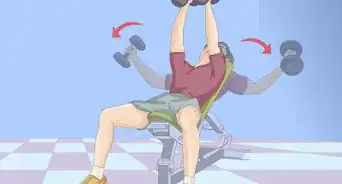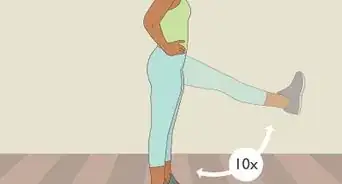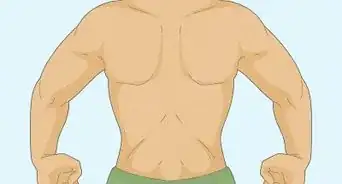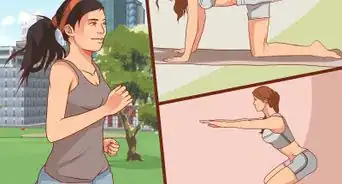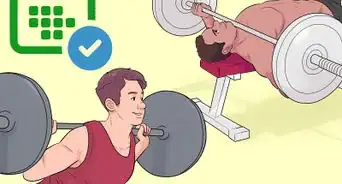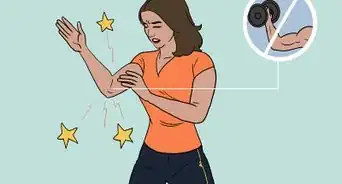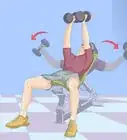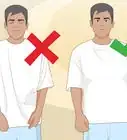This article was co-authored by Laila Ajani. Laila Ajani is a Fitness Trainer and founder of Push Personal Fitness, a personal training organization based in the San Francisco Bay Area. Laila has expertise in competitive athletics (gymnastics, powerlifting, and tennis), personal training, distance running, and Olympic lifting. Laila is certified by the National Strength & Conditioning Association (NSCA), USA Powerlifting (USAPL), and she is a Corrective Exercise Specialist (CES).
There are 16 references cited in this article, which can be found at the bottom of the page.
This article has been viewed 287,863 times.
If you want to get rid of stubborn body fat, adding strength training to your exercise regimen can help. To start losing fat, create a consistent weekly routine to build muscle and burn calories. One effective way to lose fat is doing compound exercises, which will work out multiple muscle groups at once. Keep in mind that to lose fat, you must ultimately burn more calories than you eat. Thus, you should also incorporate other healthy weight loss practices into your life.
Steps
Doing Compound Exercises
-
1Try deadlifts to exercise your glutes, hamstrings, and quads. Stand straight with your feet slightly apart. Hold a dumbbell in each hand, with your palms facing towards your body. Slightly bend your legs, lowering the weights down in front of your body until they reach your knees. Slowly rise back to a standing position.[1]
- Do about 2-3 sets of 6-12 reps each if you are using heavier weights and 12-15 repetitions if you are using lighter weights.
-
2Do a bench press to strengthen your chest, front shoulders, and back. Lie back on a bench and position yourself under a racked barbell. Plant your feet flat on the ground. Arch your back slightly to keep a neutral spine. Grip the bar tightly and push up to remove the bar from the rack. Slowly lower the bar towards your chest before pushing up again.[2]
- Do 2-3 sets of 6-12 repetitions each if you want to build muscle. Aim for 2-3 sets of 12-15 reps if you want to work on endurance.
Advertisement -
3Perform dumbbell rows to help your abs, shoulders, back, and biceps. Stand with your feet shoulder-width apart. Grasp a dumbbell in each hand, with your arms straight down in front of your body. With your knees slightly bent and your back straight, lean forward while keeping your abs tight and your chest facing down. Bend your elbows to pull the dumbbells up until your shoulders squeeze together. Hold for a second before slowly lowering them back down.[3]
- With heavier weights, repeat this exercise 6-12 times for 2-5 sets. If you use lighter weights, go for 2-3 sets of 12-15 repetitions.
-
4Do a single-arm dumbbell press to work your arms and shoulders. Hold the dumbbell at shoulder height with your arm bent. This is the starting position. Slowly extend your arm up until it is straight. Keep your shoulder down while you do this; do not lift it towards your ear. Hold this pose for a second before slowly lowering it down to starting position.[4]
- With heavier weights, repeat this exercise 6-12 times on each arm for 2-5 sets. With lighter weights, do 2-3 sets of 12-15 reps for each arm.
-
5Add dumbbells to squats for a good lower body workout. Hold a dumbbell in each hand. Stand with your feet shoulder-width apart. Lower yourself by bending your knees, but keep your back straight. Your knees should be straight over your toes. Once your thighs are parallel to the ground, rise back up slowly to a standing position.[5]
- You can hold the dumbbells straight out in front of your or straight down your sides. Don't move your arms as you squat.
- Do 2-3 sets of 6-12 repetitions if you are using heavy weights. Aim for 2-3 sets of 12-15 reps if you are using light weights.
- Squats will work your glutes, hamstrings, quads, and adductors.
-
6Hold dumbbells while doing lunges to help your thighs and glutes. While standing, hold a dumbbell in each hand. Step forward with 1 leg while keeping the other leg back. As you do this, lower your hips towards the floor. Your knees should be bent at 90-degree angles. Move your legs back into a standing position.[6]
- Do 2-3 sets of 6-12 repetitions with heavy weights or 2-3 sets of 12-15 reps with light weights.
Creating a Strength Training Regimen
-
1Work out your entire body 2 or 3 times a week. Do not lift weights too often, or you could injure yourself. Your muscles need time to repair after a session of lifting weights. Generally, 2 days of rest in between weight-lifting sessions will give you enough time to rest and repair before you use weights again.[7]
- When you do work out, go with compound strength training exercises for an effective way to lose fat. These are exercises that work out multiple muscle groups at once.
-
2Pick the right weight for your goals. No matter what type of weight you choose, you will burn calories. That said, if you want to build muscle, you should choose heavier weights. Pick weights that are heavy, but not so heavy that you can't complete a full set. If you want to build endurance, go for lighter weights.[8]
- If you are using heavier weights, you should do fewer repetitions to help you build muscle. Doing 6-12 repetitions in a set is a good guideline.
- If you are using lighter weights for endurance, do more repetitions in a set. Aim for 12-15 repetitions per set.[9]
- Repetitions (or reps) are the number of times you repeat an exercise. A set contains a certain number of repetitions that you do before you rest.
-
3Rest for a minute or less between each set. Resting allows you to catch your breath, but if you are trying to lose weight, avoid resting for too long. Keep your breaks to no more than a minute. If you need longer to rest, your weights may be too heavy.[10]
-
4Work on form rather than speed or weight. To get the most out of weight lifting, you need to make sure you have proper form. When learning a new technique, practice with no weights first to master the form. Improper form can lead to injuries, and it will reduce the benefits you receive from lifting weights.[11]
- Use online videos, bodybuilding blogs, and sports training websites to help you learn the proper form of any move you want to learn.
- At your gym, you can ask for a personal trainer to teach you the proper form of new exercises.
-
5Increase your weights over time. As time goes on and you get stronger, you can increase the weights that you lift to help build more muscle and burn more fat. Gradually add on weight in 1–5 pounds (0.45–2.27 kg) increments to make sure that you don't overdo it.[12]
-
6Add cardio to your routine to burn more calories. Lifting weights can help you build muscle and burn calories, but cardio is still useful when trying to lose fat. There are many ways that you can incorporate cardio into a weight-lifting routine. Choose a program that works for you.[13]
- Start your workout with a 10-minute run on the treadmill, bike ride, or elliptical session. At the end of the workout, do another 10 minutes to cool down.
- Do 5 minutes of cardio in between weight lifting sets. Jump on the treadmill, elliptical, or stationary bike.
- Do a full 30-45 minute cardio routine 2-3 times a week. Do these on days when you don't lift weights.
Burning Fat and Calories
-
1Track the calories that you eat using a weight loss website or app. Use an online calorie tracker like SuperTracker or an app like My Fitness Pal to watch what you eat each day. Record how many calories are in each serving of food or drink. Also add the number of calories you burned from exercise.[14]
- To lose fat, you must burn more calories than you eat.[15] You need to burn 3,500 calories to lose 1 pound (0.45 kg) of fat. To make this more manageable, aim for a calorie deficit of 500 calories a day.
- Keep in mind that muscle weighs more than fat. As you build muscle, you may become heavier, but you may still be losing fat.
-
2Get enough protein in your diet to support building muscle. Protein can help you build and maintain muscle, but your diet shouldn't be more than 35% protein. You should eat about .37 grams of protein for every 1 pound (0.45 kg) of body weight. Protein-rich foods include eggs, meats, fish, and cottage cheese.[16]
- For example, you might eat scrambled eggs in the morning, a peanut butter sandwich for lunch, and grilled chicken for dinner.
-
3Eat complex carbohydrates to give you energy. Carbohydrates can give you energy while you lift weights. The best carbs are complex carbs, which also give you fiber, vitamins, and minerals. Complex carbs include whole grains, oatmeal, lentils, and beans. Avoid simple carbs, like sugar, baked goods, white rice, pasta, and soda.[17]
- Carbs should make up between 45-65% of your diet.
-
4Choose unsaturated fats to store energy for your muscles. Fats should make up 20-30% of your diet. Look for healthy fats (known as unsaturated fats), such as olive oil, fish, nuts, and avocados. Avoid saturated fats, like fried food, margarine, and fatty meats.[18]
-
5Use body fat measurements to track your progress instead of a scale. Muscle weighs more than fat. If you build muscle, you may weigh more, even if you are shedding fat. Body fat measurements are a better way to check your progress. Some common measurements include:[19]
- Using body calipers at home or at a gym.
- Using a body fat scale or monitor at a gym or doctor's office.
- Undergoing water displacement at a large hospital or health facility.
- Getting a DEXA scan from a doctor or health spa.
Community Q&A
-
QuestionI just joined a gym and I've lost 4 lbs, only using the bicycle and rowing machines. Should I do weights as well? Will growing my muscles increase my weight?
 Community AnswerYou should start incorporating weights into your routine. The biking and rowing are great cardio, and you will continue to lose weight if you keep it up. You're right that muscle growth will cause weight gain, muscle weighs more than fat, but it will not be so much of a concern if you're not doing serious bodybuilding. Furthermore, you should embrace being strong, rather than obsessing over the numbers on the scale.
Community AnswerYou should start incorporating weights into your routine. The biking and rowing are great cardio, and you will continue to lose weight if you keep it up. You're right that muscle growth will cause weight gain, muscle weighs more than fat, but it will not be so much of a concern if you're not doing serious bodybuilding. Furthermore, you should embrace being strong, rather than obsessing over the numbers on the scale. -
QuestionWhy do I need to use weights? They just weight you down.
 Community AnswerUsing weights make your body work harder and put on muscle. Muscle burns fat, so gaining muscle makes you burn fat more effectively. There are plenty of articles on the benefits of weight training for fat loss.
Community AnswerUsing weights make your body work harder and put on muscle. Muscle burns fat, so gaining muscle makes you burn fat more effectively. There are plenty of articles on the benefits of weight training for fat loss. -
QuestionHow do I get rid of flabby underarm skin?
 Community AnswerIt is impossible to spot reduce fat deposits (such as underarm fat). In order to lose weight over your entire body, which will reduce the amount of fat in your arms, you must eat with a calorie deficiency (meaning you eat fewer calories than you spend). You can do this by either reducing the amount of food you eat or exercising.
Community AnswerIt is impossible to spot reduce fat deposits (such as underarm fat). In order to lose weight over your entire body, which will reduce the amount of fat in your arms, you must eat with a calorie deficiency (meaning you eat fewer calories than you spend). You can do this by either reducing the amount of food you eat or exercising.
References
- ↑ https://www.self.com/story/compound-exercise-benefits-strength-training
- ↑ https://www.bodybuilding.com/fun/how-to-bench-press-layne-norton-complete-guide.html
- ↑ https://www.muscleandfitness.com/workouts/back-exercises/videos/dumbbell-row
- ↑ https://www.menshealth.com/exercise/single-arm-overhead-press
- ↑ https://www.muscleandfitness.com/workouts/leg-exercises/videos/dumbbell-squat
- ↑ https://www.bodybuilding.com/exercises/dumbbell-lunges
- ↑ https://www.nerdfitness.com/blog/strength-training-101/
- ↑ https://www.health.harvard.edu/exercise-and-fitness/7-tips-for-a-safe-and-successful-strength-training-program
- ↑ https://www.nerdfitness.com/blog/the-correct-number-of-reps-per-set-in-the-gym/
- ↑ https://experiencelife.com/article/lift-to-lose-weight/
- ↑ https://www.health.harvard.edu/exercise-and-fitness/7-tips-for-a-safe-and-successful-strength-training-program
- ↑ https://www.health.harvard.edu/exercise-and-fitness/7-tips-for-a-safe-and-successful-strength-training-program
- ↑ https://www.self.com/story/the-workout-you-need-to-do-if-youre-trying-to-lose-weight
- ↑ https://www.mayoclinic.org/healthy-lifestyle/weight-loss/in-depth/calories/art-20048065
- ↑ Laila Ajani. Fitness Trainer. Expert Interview. 31 October 2019.
- ↑ http://www.eatright.org/resource/fitness/training-and-recovery/building-muscle/strength-building-and-muscle-mass
- ↑ http://www.eatright.org/resource/fitness/training-and-recovery/building-muscle/strength-building-and-muscle-mass
- ↑ http://www.eatright.org/resource/fitness/training-and-recovery/building-muscle/strength-building-and-muscle-mass
- ↑ https://experiencelife.com/article/lift-to-lose-weight/
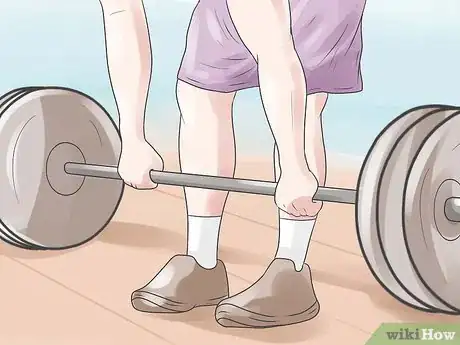
-Step-13.webp)


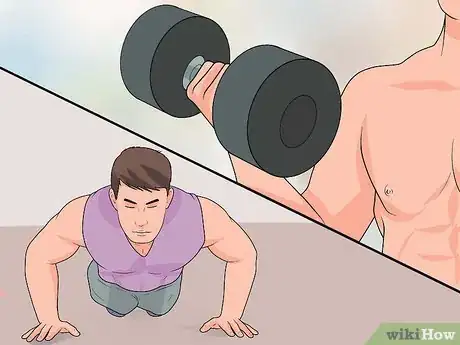
-Step-14.webp)




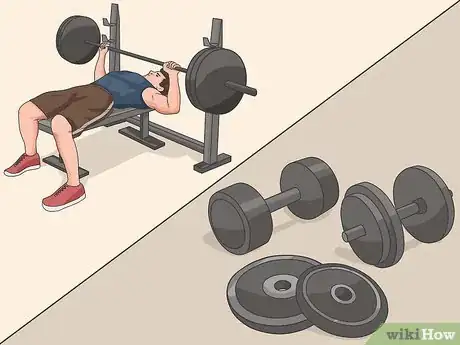

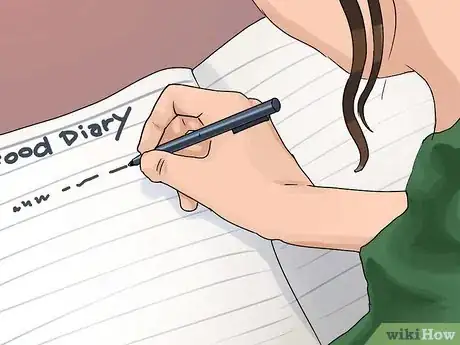

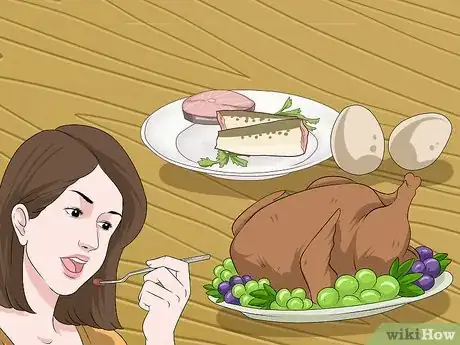
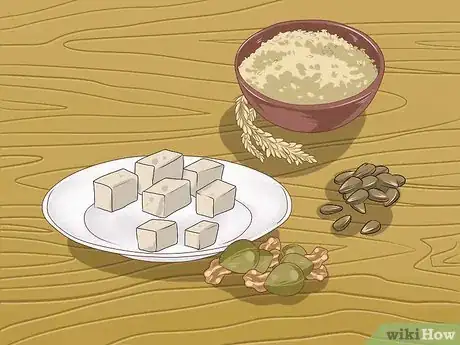
-Step-1.webp)
-Step-12.webp)
